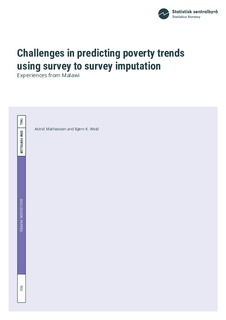| dc.description.abstract | Poverty in low-income countries is usually measured with large and infrequent household surveys. A challenge is to find methods to measure poverty more frequently.
The objective of this study is to test a method for predicting poverty, based upon a statistical model utilizing consumption surveys and light annual surveys. A decade of poverty predictions and regular poverty estimates in Malawi provides us with a unique real-life experience to better understand the suitability of such approaches to monitor trends in poverty.
The analysis from Malawi suggests that a modelling approach works per se, given that information on the household’s demographic composition is included in the model. The main challenge when predicting onto other surveys seems to be related to comparability between the surveys. Differences in implementation, questionnaire design and survey sample size are aspects that may contribute to incomparability of data collected between the surveys. | nb_NO |
